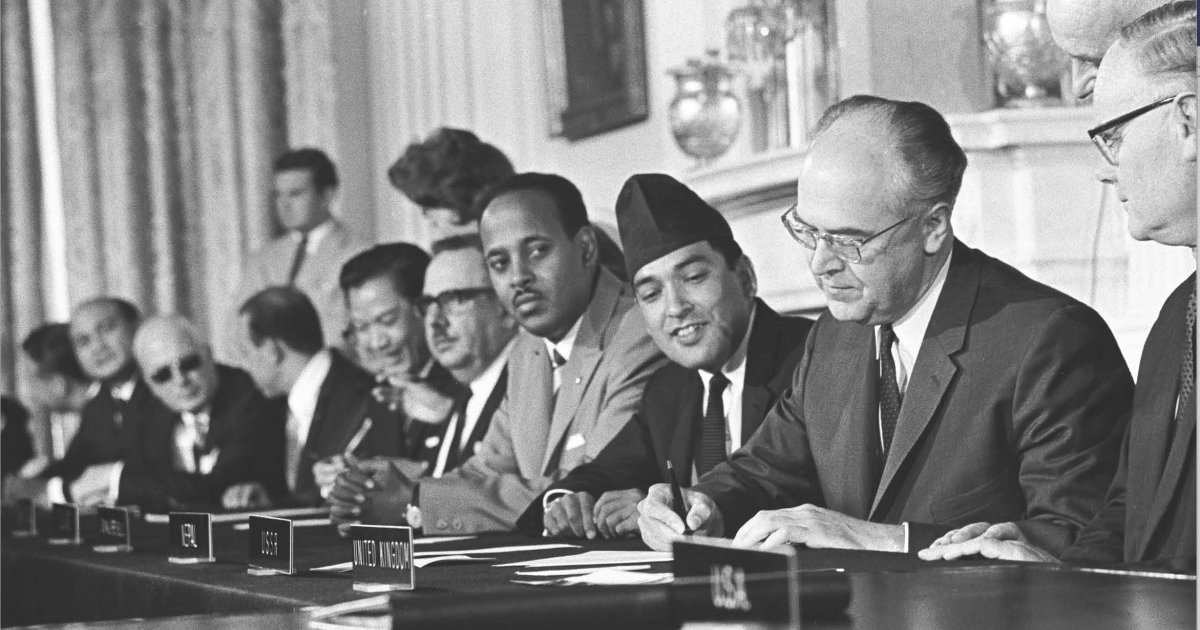Nuclear Weaponry: A Deterrence of War or a Perpetuation of “Ungrievable” Violence?
Solemn faces and sweaty palms, the adults of an orthodox joint family in Multan sat around a singular coffee table on their veranda. All eyes are on the black pistol sitting front and center adjacent to a mundane cup of chai. No one dared say what everyone was thinking.
It was a good thing they now had a gun in the home for self-defense, but why was it owned by the youngest son only? Why was it to be placed in his room, under his control? If they got into an argument, would it be used against them? And what if one of the children got hold of it? Maybe everyone should buy their own before one person has too much power.
Before the others could even present such an idea, Baba announced no more pistols were going to enter this home. The youngest could keep his, just in case, but no more would be sought.
While this makes sense, to protect us from normalizing violence, there now exists a power imbalance between siblings, even if the youngest promises not to use it to hurt anyone unless necessary. Now everyone will have no choice but to sleep with one eye open at night.
This is precisely what nuclear weaponry did to the global community, fueling nuclear warfare and creating imbalances amongst allies. Nuclear weapons have long been a topic of controversy and fascination, representing immense destructive power capable of altering the course of history. The most significant of which being the generations lost in Hiroshima and Nagasaki. The possession of nuclear weapons by states is often justified on the grounds of deterrence, the belief that their existence prevents conflicts and maintains peace as well as acts as a self defense mechanism should the need arise.1Robert Rauchhaus ‘Evaluating the Nuclear Peace Hypothesis: A Quantitative Approach’ (2009) 53(2) The Journal of Conflict Resolution 258, https://www.jstor.org/stable/20684584 accessed 7 June 2023 However, the effectiveness of nuclear deterrence remains a subject of debate, with some arguing that these weapons fuel low-level conflicts, while others emphasize their role in preventing major wars. This article aims to explore the complex relationship between nuclear weapons, deterrence, and their potential influence on conflicts at various levels and whether the theory of nuclear deterrence is as effective as it is portrayed.
The debate surrounding nuclear weapons and their role in warfare is multifaceted and complex. While proponents argue that these weapons have prevented major wars through the logic of deterrence, critics contend that they contribute to lower-level conflicts and pose significant risks to regional and global stability. As the international community continues to grapple with the challenges of nuclear proliferation and evolving threats, striking a balance between deterrence and disarmament becomes increasingly vital, especially while keeping in mind the inequitable distribution of power and privilege amongst armed and unarmed signatories of well-meaning treaties like the NPT (Treaty on the Non-Proliferation of Nuclear Weapons), START (Strategic Arms Reduction Treaties), CTBT (Comprehensive Nuclear-Test-Ban Treaty) and TPNW(Treaty on the Prohibition of Nuclear Weapons).
Treaty on the Non-Proliferation of Nuclear Weapons
For some context, the Treaty on the Non-Proliferation of Nuclear Weapons, or the NPT, which entered into force in 1970, is one of the cornerstone agreements concerning nuclear weapons.2Lawrence D. Freedman, ‘Treaty on the Non-Proliferation of Nuclear Weapons’ (Encyclopædia Britannica, 21 May 2023) https://www.britannica.com/event/Treaty-on-the-Non-proliferation-of-Nuclear-Weapons accessed 8 June 2023 It has three main pillars: non-proliferation, disarmament, and peaceful use of nuclear energy.3Ibid The treaty aims to prevent the multiplication and expansion of nuclear weapons while promoting cooperation in the peaceful use of nuclear energy. The NPT has been signed and ratified by most countries globally.4Ibid However, the problematic end of this treaty lies in where non-nuclear power-holding states have agreed to forsake their right to acquire nuclear power, while nuclear power-holding states sign this treaty in a promise to avoid using nuclear warfare unless absolutely necessary. Furthermore, countries holding this power have also withheld their signature, including India, Pakistan and Israel. North Korea even retracted their own signature in 2003. The very foundations of this treaty are inequitable. And with such weak bases, we cannot expect the NPT to be efficacious.
The theory of nuclear deterrence
At its core, the theory of nuclear deterrence posits that the possession of nuclear weapons by a state will dissuade potential adversaries from attacking due to the fear of catastrophic retaliation. This notion assumes that rational actors will prioritize self-preservation over aggression, recognizing the grave consequences that nuclear warfare would bring. Proponents argue that the existence of nuclear weapons has indeed prevented major conflicts between nuclear-armed states since the end of World War II. An example closer to home is the stifled aggression between India and Pakistan, and the only thing holding off a nuclear war is that both sides are adequately armed5Devjyot Ghoshal, ‘Factbox: India and Pakistan’s Nuclear Arsenals’ (Reuters, 11 March 2022) https://www.reuters.com/world/asia-pacific/india-pakistans-nuclear-arsenals-2022-03-11/ accessed 8 June 2023 and the prospect of both signing a regulatory treaty like the NPT.6Anant Phadke ‘Preventing Nuclear Arms Race between India and Pakistan’ (1988) 23(34) Economic and Political Weekly 1741, https://jstor.org/stable/4378927 accessed 7 June 2023 However, the increase in distressing hostilities to make up for the lack of usage does not stand unnoticed.
Preventing Major Wars
Supporters of nuclear deterrence contend that these weapons have played a crucial role in preventing large-scale conflicts. The specter of mutually assured destruction (MAD), wherein any attack would result in a devastating counter strike, creates a strategic environment of caution and restraint. This concept has held true during tense periods like the Cold War, where the presence of nuclear weapons helped maintain a delicate balance of power between the United States and the Soviet Union. However, one must bear in mind that the Cold War also perpetuated multiple deadly proxy wars throughout the world, from Cuba till Korea.
The reality formed from theory: Ambiguity and Instability
On the other hand, critics argue that the possession of nuclear weapons introduces a level of ambiguity and instability into the international system. Smaller, non-nuclear states may feel compelled to engage in conflicts that fall below the nuclear threshold, believing that the nuclear-armed states would hesitate to risk a full-scale exchange. In this view, nuclear weapons act as an enabler of low-level conflicts, fueling regional rivalries and proxy wars where the risks of escalation are perceived to be lower. What remains a more problematic angle is when the lives in these regional rivalries are pegged as of lower value than the lives of those living in the developed world. Judith Butler classifies these groups as the ‘grievable’ and the ‘ungrievable’, which perpetuates the idea that human life has a differential exchange value in the marketplace of death.7Judith Butler ‘Nonviolence, GrievabilIty and the Critique on Individualism’ (Meiji University) https://www.meiji.ac.jp/bungaku/info/2018/6t5h7p00000tl309-att/a1545207937961.pdf accessed 7 June 2023 Making the products of violence in post-colonial countries like Vietnam and Afghanistan less of an atrocity in the eyes of the international community, than the lives of those in Caucasian majority states.
Proliferation and Regional Security
The spread of nuclear weapons to more states, like North Korea, further complicates the dynamics of deterrence. As more nations acquire nuclear capabilities, the stability of the global nuclear order becomes increasingly fragile. While some argue that additional nuclear-armed states can enhance stability by creating a more balanced deterrent environment, others express concern about the potential for accidents, miscalculations, or non-state actors gaining access to these weapons.8Scott D. Sagan ‘The Perils of Proliferation: Organization Theory, Deterrence Theory, and the Spread of Nuclear Weapons’ (1994) 18(4) International Security 66, https://www.jstor.org/stable/2539178 accessed 7 June 2023
Evolving Threats and New Challenges
In today’s world, the challenges posed by nuclear weapons extend beyond traditional state-to-state conflicts. Non-state actors, such as terrorist organizations, may seek to acquire or use nuclear materials for catastrophic purposes. Additionally, emerging technologies, such as cyber warfare, could undermine traditional notions of deterrence, potentially bypassing nuclear defenses and escalating tensions in unconventional ways.
Conclusion
Ultimately, the world must strive for comprehensive strategies that address the underlying causes of conflicts, reduce reliance on nuclear weapons, and promote peaceful resolutions. Such efforts should prioritize disarmament while ensuring the security concerns of states are adequately addressed. Only through continued dialogue, transparency, and cooperation can we hope to move closer to a world free of the devastating specter of nuclear warfare.
The opinions expressed in the articles on the Diplomacy, Law & Policy (DLP) Forum are those of the authors. They do not purport to reflect the opinions or views of the DLP Forum, its editorial team, or its affiliated organizations. Moreover, the articles are based upon information the authors consider reliable, but neither the DLP Forum nor its affiliates warrant its completeness or accuracy, and it should not be relied upon as such.
The DLP Forum hereby disclaims any and all liability to any party for any direct, indirect, implied, punitive, special, incidental or other consequential damages arising directly or indirectly from any use of its content, which is provided as is, and without warranties.
The articles may contain links to other websites or content belonging to or originating from third parties or links to websites and features in banners or other advertising. Such external links are not investigated, monitored, or checked for accuracy, adequacy, validity, reliability, availability or completeness by us and we do not warrant, endorse, guarantee, or assume responsibility for the accuracy or reliability of this information.

Gul Zahra Ali
Gul Zahra Ali is a 3rd year Law student at LUMS and is currently pursuing a minor in Public Management. Her primary interests lie in Public Policymaking and Anthropological History. She hopes to expand her experience with international law and human rights to connect it with domestic policies and their execution. Her extracurricular experiences and internships diversify and enrich her perspective, allowing greater insights.

